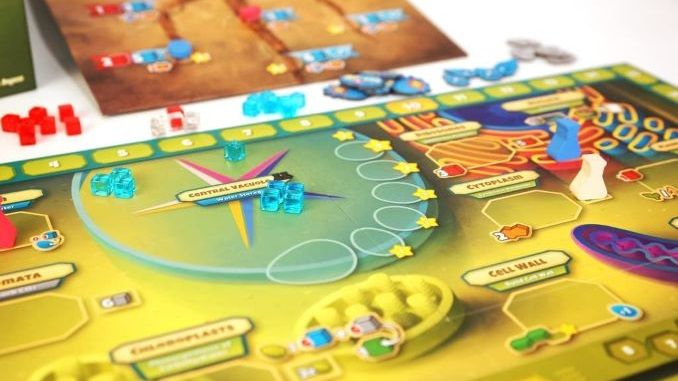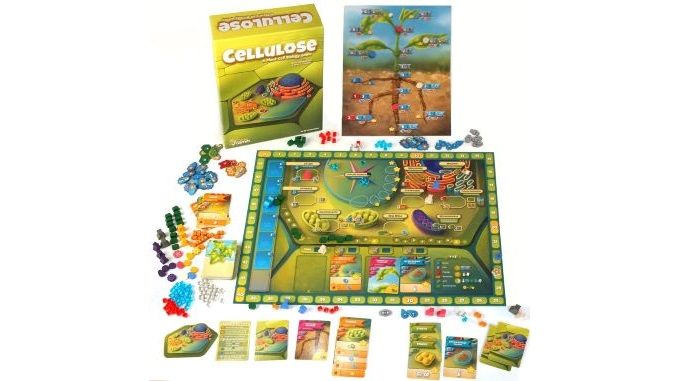The Board Game Cellulose Makes Science Fun, and You Might Actually Learn a Little Something from It, Too
Games Reviews board games
Cellulose: A Plant Cell Biology Game is the latest game from Genius Games and owner John Coveyou, who co-designed this title with Steve Schlepphorst. It’s part of their line of science education games that includes Cytosis, Subatomic, Periodic (played on the periodic table), and last year’s Genotype, which was their best (and best-looking) game to date.
Cellulose is a sort of spiritual sequel to Cytosis, which earned a commendation from the Journal of Cell Science; both are worker placement games built around the inner workings of a biological cell, with many of the typical trappings of light Euro games. Players have to decide whether to just focus on resource management, building quickly to push towards the end game, or to try to build more of an engine using the valuable cards and the game’s version of a tech tree, falling behind early in points but making later rounds much more productive.
In Cellulose, the biggest points come from contributing to the shared construction of the cell wall. When you get six water resources and six CO2 resources, you can use the photosynthesis action to create one cellulose unit; on a subsequent turn, you can use the cell wall action to add one cellulose unit to the wall, gaining anywhere from six to 12 points depending on where you are in the wall. The action spaces where you place a worker to get more water or more CO2 are both more valuable for the first player to go there in each round, which is the case with almost every action space on the board other than cell wall construction.
There is an engine-building path within Cellulose if you’re willing to be patient. You can convert cellulose to five or six mitochondria—they’re the powerhouses of the cell, in case you forgot—and then use those, protein cubes, and sometimes water to buy cards that give you one-time or ongoing bonuses. The best ones come from enzyme cards, which you use once for free, and then can reuse for one protein cube any time you play another enzyme card, creating a chain of free actions as long as you have the protein to pay for it.
At the start of every round, players receive water and CO2 based on their tokens’ locations on the game’s tech tree—an actual tree, on a separate board, where each player has two tokens. The one above the ground grants CO2, and the one below grants water, with the amounts increasing as you pay resources (plant hormones, and later mitochondria) to move your token. The upper branches and the lower roots give you different choices of rewards, which can grow to include additional victory points or other bonuses.

If you go the engine-building route, boosting yourself on the tech tree and picking up some cards, you miss out on the most valuable spots on the cell wall, but set yourself up to end up with large resource gains after three or four rounds, at which point you might be able to build several times per round, and can focus your workers on photosynthesis and cell wall construction or on buying cards.
The strongest science element might be the central vacuole space on the main board, although it’s the least integrated into the game itself: When you collect water resources, you can choose to donate up to three of them to the central vacuole. At the end of each round, the player with the most water donated to the vacuole gets one to four bonus points and the use of a bonus worker for the following round—a huge benefit in a game where players have just three workers apiece (four in a two-player game).
As worker-placement games go, it’s solid—you have plenty of options, but there’s a little strategy involved in where you place your first workers in each round because almost every action space is more valuable for the first person to go there. The fact that a straight resource/build strategy is competitive is probably the strongest part of the game, as it can help speed the game up—it ends when the cell wall is complete—and forces players trying to build engines to keep one eye on the scoreboard.
I’ve played this a few times, including in its solo mode, and I don’t doubt its scientific accuracy, but I think you can play this game without absorbing any of the science within it. A big part of the science in the game is in the cards, and you can play without using the cards much, or just might not see a lot of those cards in one play. I’m not saying that the mechanics fail to match the science, but that you can play without learning much about the science of the cell. That’s a high bar to clear, one that most board games don’t have to even consider.
There is a solo mode included, with an automa player that uses a deck of action cards to which you add as the game progresses. The automa gains water and CO2 resources rather easily, and racks up points from building the cell wall and from acquiring cards, while also occupying valuable placement spaces on the board to prevent you from using them. The icons on the action cards are abstruse, but after re-reading the solo rules section of the book, I got the hang of the solo mode’s unique mat where you move a token to choose a specific strategy for the automa player, which then adds a new action card specific to that strategy to the deck.
If you like worker-placement games, and want something that’s easy to learn and offers some educational value beyond what most games can give you, Cellulose (and its predecessor, Cytosis) would be worth checking out. I don’t think it’ll help you with the AP Bio exam, though.
Keith Law is the author of The Inside Game and Smart Baseball and a senior baseball writer for The Athletic. You can find his personal blog the dish, covering games, literature, and more, at meadowparty.com/blog.